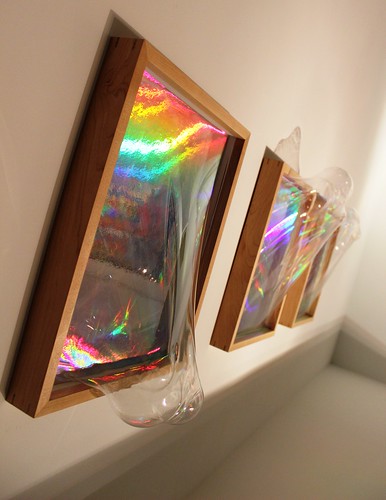Review: FUTURESPECTIVE
Review: FUTURESPECTIVE

Exciting times are ahead in Miami. With a striving art scene and young artists making names for themselves internationally the city has become part of the art conversation. “Futurespective,” the group show presented by the Rozenblum Foundation and the Michael Margulies Artist Agency, encapsulates Miami’s new era while highlighting significant developments in the city.
“Futurespective” focuses on a forward-driven vision and new discoveries. Each participating artist interprets the theme differently, inspired by the streets of Miami, history and through explorations of movement, structure and new media.
Curator Kiki Valdes explains, “For me, it’s about helping to define and discuss where some Miami artists are going in their respective arts practices. The gallery circuit in Miami is still scarce. I’m not bashing it, it’s a simple reality. This show is in a way addressing that void of the art to patron experience in Miami.”
The inspirations for these works approaching the subject of future are rooted in the past and present. The streets of Miami inspired the pieces by Jel Martinez who explores erasure , texture and the world of graffiti. Says Martinez, “There is an ongoing battle between the vandal and the city and this battle creates patches, different styles and radical shapes.” He explains further, “ I am three characters. I am the contractor who builds the wall I am the vandal who attacks the wall and I am also the city employee who erases the graffiti from the wall.”
The streets are also the basis for the art of Ruben Ubiera, who manages to balance fine art and street art successfully. Centered around urban life and the Diaspora culture of Miami, Ubiera adds his own spin to a vision of Miami’s future. By challenging himself to a site-specific installation with little rendering Ubiera broke out of his comfort zone and out of the past to embrace a new vision.
History is an integral part of the work of Ubiera and Christopher Carter, who both incorporate found objects and materials into their works. Carter used wood, from a barn in Carver, Massachusetts, which manufactured cannon balls for The Battle of 1812 and was later a belt driven machine shop for armaments during WWI but added neons as a symbol of Miami and the city’s lights of the present
George Sanchez-Calderon explores the modern condition through history and art history. His work references Levittown, a Philadelphia community developed in response to the United States’ post-war housing needs , which forever changed the American urban and suburban landscape.
Experimentation with new media, textures and movement are integral to the work of the artists in “Futurespective.” Johnny Robles explores nature, physics and childhood memories in his recent work of “creating bubbles and the meditative process of how bubbles form and change shape through air and tension yet retain a subtle fluidity of form.”
David Marsh is interested in the basic elements of paintings and materials and Valdes’ paintings are testimony to his movement and development as an artist. His experimentation with material and layering of canvas in earlier works merge process, energy and a visual component while his newer painting “explores the ability, limitations and advantages of using sex in the context of cartoon imagery.”
The visions moving forward are the essence of “Futurespective.” The works in the exhibit, made in the past and present represent and define the future of the artists. Says Valdes, “All of the artists aren’t ready for a fancy retrospective, but if we freeze time and look at right now, we can see what might end up in their future retrospective. That’s if most some of the artists reach that point someday. The show is really to question Miami, how the work is created and presented for years to come.”
– Words by Heike Dempster
